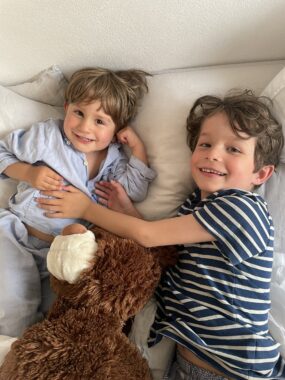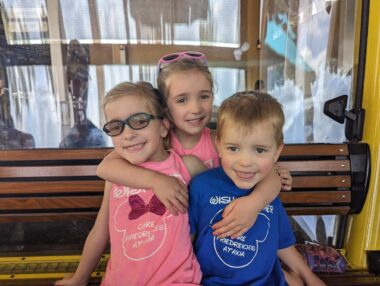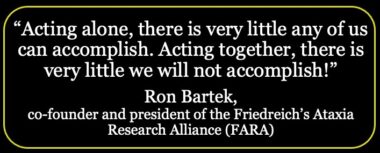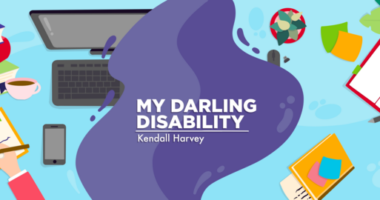A Christmas wish for an FA treatment our beloved kids can take
3 mothers report how early diagnoses are challenging their families this year

The magic of the season belongs to children — their laughter, joy, and beaming smiles. Though the pediatric population isn’t always seen at events for Friedreich’s ataxia (FA), their value and presence are no less real in our community.
I’ve met many incredible caregivers with a deep love for their young children, including one, Helena H. Larsson, whose family was driven by such devotion that they created the first foundation to focus on ataxia in Scandinavia. Inspired by these children and their unwavering parents, I have the privilege of sharing small parts of some of their stories.
Warm wishes from Sweden, by Helena H. Larsson
Sending you my best wishes from a winter wonderland. Stockholm is covered in snow!

Lev, left, and Tom are already facing the reality of Friedreich’s ataxia. (Courtesy of Helena H. Larsson)
My sons, Lev and Tom, are only 3 and 6 years old, respectively, but are already facing the reality of FA. They are my superheroes and the loves of my life.
Tom used to be the most energetic, vibrant child we’d met. Then a drastic change occurred. At 3 and a half years old, he began complaining about rapid heartbeat and chest pain; then his gait and posture changed. We realized something was wrong.
He started school this year, and that’s been exciting, but also anxiety-provoking. Tom was diagnosed with FA just before school started, so that’s meant a lot of challenges, given his weekly hospital visits. The doctors are tracking him, but not treating him. He asks us when he won’t have to visit the doctors anymore and when his heart will work well again. We reassure him that there will be something for him soon.
Lev, who also has FA, is a bundle of joy, always radiating cheerfulness and kindness. The kids are amazing; they never question why they have all the doctors’ visits and take their eight supplements every morning. Tom’s sense of humor is real, and Lev is always shining with his happiness.
We laugh so much together, but at night I cry until I fall asleep. Yet waking up next to them is everything and will keep us doing anything we can to save our children’s lives.
A prayer for treatment from Michigan, by Rebecca Lange

From left, Arlee, Annie, and Abel vacation at Disney World. (Courtesy of Rebecca Lange)
My husband and I have been blessed with three wonderful children: Arlee, 7; Annie, 4; and Abel, 3. Arlee is a fun, witty, and caring bookworm. Abel loves to make people laugh and is so sweet, full of life and energy.
When Arlee was 3, we noticed she was struggling. After two years of appointments, we received her diagnosis of FA in January. We decided to have our two younger children tested. Annie tested negative, but Abel was positive. He was just 2 years old.
We were heartbroken. Arlee loves to travel and wants to be a pop star when she grows up. She’s always singing and dancing. Living with FA and knowing that the doctors cannot fix her now has been emotionally hard for her. Nonetheless, she’s been a big support for Abel during his blood draws, EKGs, and echocardiograms.
Arlee tries to keep him calm and shares how to make the doctors’ appointments better. Abel adores his big sisters, trucks, dinosaurs, and anything that can get loud or dirty. We pray constantly that his symptoms continue to hold off, since we know that early onset correlates with more severe and rapid disease progression.
We’re so excited that a treatment, Skyclarys (omaveloxolone), has been approved for FA, though bittersweet because our kids are too young to access it. We have no idea how long it will take, and for our kids, time is not on their side. Our family’s hope is in God. He knows how it will all play out, and we’re continuously praying for the doctors, researchers, and advocates for FA.
Holding out hope for 2024 from New York, by Sarah DuVall
We learned our two children had FA when our 6-year-old son, Henry, became sick with the flu and was suddenly slurring and unable to walk. We thought we might lose him. We’d already been on a six-year quest to understand the mystery symptoms our 10-year-old, Nathan, was experiencing.
When we received the test results revealing their diagnoses, our hearts were shattered. Our happy, hopeful boys were confronting the slow loss of their independence, with the accompanying emotional toll.
Nathan loves music and hopes to be a composer, and Henry is passionate about cooking and wants to work with animals. We’re eternally grateful to have Henry with us this year after his struggles, and we appreciate the precious time we spend with them more than ever.
FA’s first treatment, Skyclarys, became available for ages 16 and older this year, but FA’s impact is far outpacing the delays in clinical trials that could help the youngest with the disease.
We hope that 2024 will open more doors.

(Graphic by Elizabeth Hamilton)
Note: Friedreich’s Ataxia News is strictly a news and information website about the disease. It does not provide medical advice, diagnosis, or treatment. This content is not intended to be a substitute for professional medical advice, diagnosis, or treatment. Always seek the advice of your physician or another qualified health provider with any questions you may have regarding a medical condition. Never disregard professional medical advice or delay in seeking it because of something you have read on this website. The opinions expressed in this column are not those of Friedreich’s Ataxia News or its parent company, Bionews, and are intended to spark discussion about issues pertaining to Friedreich’s ataxia.








Deborrha Armstrong
Elizabeth, thank you for capturing the hopes and hearts of these families and their precious children. My prayer is that every child impacted by FA will have access to effective treatment NOW. I’m believing for it.
Nick Herring
We echo all of these sentiments. Our daughter Avery was diagnosed at 6 and is now 8. We are anxiously waiting for her chance to take this potentially game changing drug. We know it’s potential to slow progression and see everyday what a monumental impact that could mean for Avery and all the other children with FA. We are praying daily for progress towards access. When Omav was approved I never thought a trial for children would take so long to get started. Our kids need every chance at a better life. I’ll be praying for all our FA kids.
Alwynn Mellen
Our 10 year old daughter was diagnosed at age 7. We too were excited for the FDA approval of Skylarys and remain hopeful for a treatment for FA, something to allow our daughter to remain strong and mobile. Like all parents, we want her to be able to participate in activities with her friends and have the function and confidence to try new experiences. We hope for her to have a future that isn't limited by this debilitating disorder. Thank you for this article. It helps to know we aren't alone.